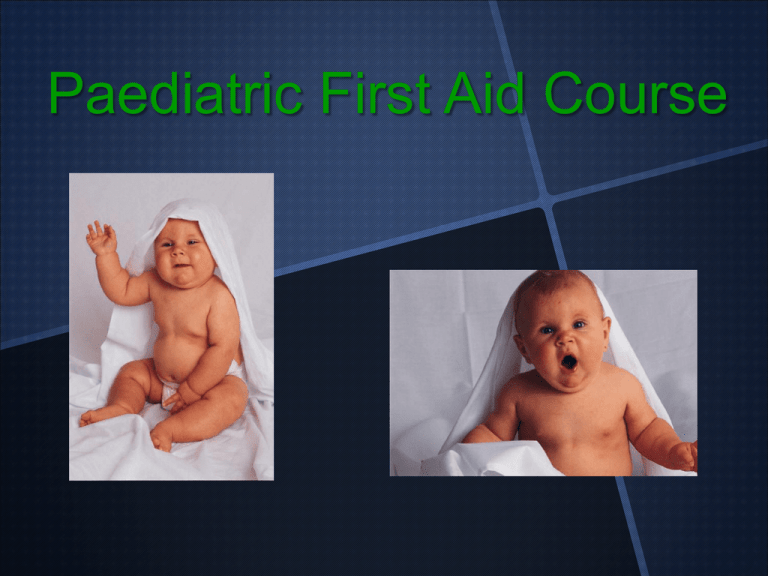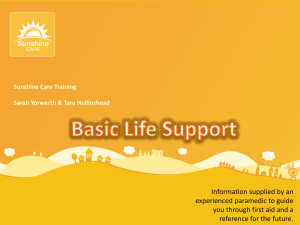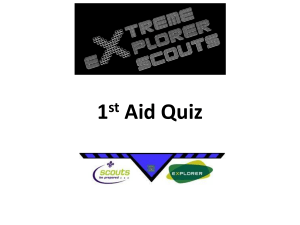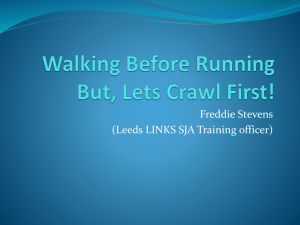PAEDIATRIC-2013 - First Aid Training Excellence
advertisement

Paediatric First Aid Course Introduction to your course work book House Rules Mobile phones switched off Toilets Break times Start and finish times Competence assessment CPR practical session Incident training Certificates Paediatric First Aid Write down in your own words why you have chosen or asked by your employers to attend this course. From a personal point of view, what would you like to achieve / learn on the course What is First Aid? First Aid is the immediate assistance or treatment given to someone injured or suddenly taken ill before the arrival of a ambulance, doctor or other appropriately qualified person First Aid and the Law Acts and Regulations Health & Safety at Work Act 1974 Health & Safety (First Aid) Regulations 1981 Reporting of Injuries, Diseases & Dangerous Occurrences Regulations 1995 (RIDDOR) Risk assessment of First Aid needs To consider Workplace hazards and risks Size of the organization History of accidents Nature & distribution of work force Remoteness for medical services Needs of travelling, lone or remote workers Working on shared or multi-occupied sites Annual leave and other absences of First Aiders The Aims of First Aid Preserve life Prevent the injury from worsening Promote recovery Role and Responsibilities First Aider must always Assess Danger Prioritise Ask Treat/Transfer Managing casualties P3 Your trainer will now explain how oxygen is transferred around the body P3 Multiple casualties From the following list decide who needs your attention first. Remember you can only deal with one casualty at a time. Please give reasons for your answers. P3 Screaming child Shock Nose bleed Arterial bleed Broken leg Asthma attack Quiet child on the floor Choking Anaphylactic shock P3 Quiet child on floor Arterial bleed Choking Nose bleed Anaphylactic shock Broken leg Asthma attack Shock Screaming child P3 Triage Breathing over Bleeding over Burns over Bones P3 Primary Assessment D: Danger R: Response A: Airway B: Breathing C: Circulation P3 P4 Cardio-Pulmonary Resuscitation Adult Child Baby P4 Cardio Pulmonary Resuscitation Danger Response Airway Breathing Compressions P4 P5 Adult Unresponsive Shout for help Open airway Not breathing normally Call 999 30 chest compressions 2 rescue breaths 30 compressions P6 P6 Problems during resuscitation P9 Hygiene Considerations During Resuscitation P9 Paediatric CPR Unresponsive Shout for help Open Airway Not breathing normally 5 rescue breaths 30:2 Call 999 (x 3 cycles) 2 Rescue breaths 30 compressions P10 CPR Child 30 compressions : 2 inflations 3 cycles of 30:2 = 1 minute At least a 1/3rd depth of chest 1 hand 100 – 120 rate per minute P10 CPR Infant 30 compressions : 2 inflations 3 cycles of 30:2 = 1 minute At least a 1/3rd depth of chest 2 fingers 100 – 120 rate per minute P12 Assessing casualties Primary assessment Secondary assessment Recovery position A practical session Secondary Assessment P14 P14 Unconsciousness Causes Fainting Stroke Heart attack Shock Head injuries Hypoxia Poisoning Epilepsy Diabetes P15 The AVPU Code To check response: A Alert V Responds to Voice P Responds to Pain U Unresponsive P15 The Recovery Position P15 Choking P16 Children & babies Causes of airway obstruction Inhalation of vomit Foreign object e.g. toy, peanut Submersion in water Infection of the lungs or throat Injuries to the head, neck or chest Cot death P16 Often stand up very quickly clutching throat Congested face, veins prominent in face and neck Coughing Difficulty breathing May have been eating P16 Choking Adult Treatment Assess severity Severe airway obstruction Ineffective cough Mild airway obstruction Effective cough Unconscious Start CPR Conscious 5 back blows 5 Abdominal thrusts Encourage to cough Monitor for deterioration Encourage the casualty to cough Up to 5 sharp back slaps Up to 5 abdominal thrusts Repeat cycle Unconscious CPR Choking Paediatric Treatment Assess severity Ineffective cough Effective cough Unconscious Open airway 5 breaths Start CPR Conscious 5 back blows 5 thrusts* * Chest for infants/abdominal for child > 1 Continue to check for deterioration to ineffective cough or relief of obstruction P16 Encourage to cough Up to 5 sharp back slaps Up to 5 abdominal thrusts Unconscious CPR P16 Up to 5 sharp back slaps Up to 5 chest thrusts Unconscious CPR P17 Obtaining medical assistance In pairs write a list of information the 999 operator may ask you for Conditions that affect the breathing Causes of breathing problems Workshop Make a list of all of the conditions that could affect your casualties breathing Hypoxia Blockage Febrile convulsions Sickle cell anemia Lack of O² Poisoning Compression of chest Suffocation Gas/smoke Paralysis Electrical injury Carbon monoxide Fits P19 Anaphylactic shock Major allergic reaction Bee stings Peanuts, foods Drugs P19 Anaphylactic shock Anxiety Red blotchy skin Swelling of the face and neck Puffiness around the eyes Impaired breathing A rapid pulse P19 Anaphylactic shock Treatment Calm and reassure Get help Help the casualty to sit up if conscious Recovery position if unconscious Help them to take their Epipen P19 Asthma Where the air passages to the lungs go into spasm causing the lining of the airways to swell. The casualty then finds it difficult to breathe Causes of attack Pollen / Dust / Cigarette smoke Allergens such as pet hair Exercise P20 Asthma recognition Difficulty breathing Wheezing Distress and anxiety Difficulty in speaking Grey blue skin Dry, tickly cough May become exhausted P20 Asthma treatment Calm and reassure casualty Sit them down, leaning forward supported Plenty of fresh air Allow him to use medication If attack is prolonged or medication does not relieve attack, seek medical help P20 P22 P22 Section 7 What sudden illnesses or conditions can affect the circulatory system? P22 Shock What is it? Causes P22 Causes of shock Severe bleeding Loss of body fluids Loss of serum Severe pain Acute heart attack Abdominal emergencies P22 Shock Recognition Pale or grey skin Cold, clammy skin Feel faint or giddy Feels sick or may vomit Feels thirsty Anxious or restless Yawn or gasp for air Rapid, weak pulse Shallow, rapid breathing May lose consciousness P22 Shock Treatment Deal with the injury or cause Lay casualty down, raise legs if possible Head low and turned to one side Loosen tight clothing Moisten lips if thirsty Keep casualty warm Transfer to hospital P22 Incised Laceration Puncture Contusion Abrasion Arteries Veins Capillaries P22 Types of bleeding Arterial Severe. Bright red oxygenated blood spurts from wound with each heartbeat Venous Dark red. Blood may escape from the body as quickly as an arterial bleed, may gush profusely Capillary Oozing occurs at the site of all wounds, blood loss is usually slight P22 Pale skin with cold clammy skin Rapid weak pulse Shallow fast breathing Feels sick or may vomit Feels cold and thirsty Confused/distressed Obvious injury P23 Internal bleeding Recognition Cold, clammy skin Rapid, weak pulse Pain Thirst Confusion, restlessness Possible collapse Pattern bruising Bleeding from orifices P23 Treatment of severe bleeding Direct pressure Elevate the injury Apply a sterile dressing Transfer to hospital P23 Practical Dressings and Bandages P24 P25 P27 P27 Poisons A poison is a substance which, if taken into the body in sufficient quantity, may cause temporary or permanent damage P28 Workshop P28 Poisons How can a poison enter the body? Ingested Inhaled Instilled Injected Absorbed P28 Poisons The affects of poisons Cause confusion, fits and unconsciousness Burn lips, mouth and food passages Affect the normal action of the heart Cause vomiting & diarrhea Damage blood preventing oxygen reaching the tissues Inhaled poisons can cause severe respiratory distress P28 P30 P30 Burns and Scalds Causes Friction Dry heat Electric current Acids and alkalis Intense cold Radiation Scalds are caused by moist heat, water, steam P30 Classification of Burns Superficial: Redness, swelling, tenderness Partial thickness: rawness of skin and blisters Full thickness: scorching, damage to nerves, fat tissue and muscles P30 P30 Medical Attention Must be sought for: Full thickness burns Burns to face, hands, feet or genital area Burns that extend all around a limb Partial thickness burns greater than 1% of body surface = palm of casualties hand P30 Electricity P31 P31 P31 P31 Fractures P32 P32 P32 Open Fracture Fractured ends of the bone protrude through the skin P32 Closed Fracture When the skin is not broken P32 Complicated Fracture Leads to further damage and injury to major organs or blood vessels. P32 P32 Fractures Recognition features Casualty may hear the bone snap Pain Tenderness Swelling, bruising Loss of power Grating sound on movement Deformity P32 P32 Bones, Muscles and Joints Provides support, protects vital organs and allows movement Sprains, Strains & Dislocations Sprain is an injury to a ligament at a joint Strain is an injury to a muscle or tendon Dislocation is the dislodging of a bone head at a ball and socket joint P33 Treatment Rest Ice Comfortable Position Elevation P33 Disorders of the Brain P34 P34 The AVPU Code To check response: A Alert V Responds to Voice P Responds to Pain U Unresponsive Concussion • History of blow to the head • Brief or partial loss of consciousness • Dizziness or nausea • Loss of memory • Mild headache • Monitor and sent to hospital P34 Compression May be disorientated, confused, unconscious or weeping Progressive loss of consciousness Strong pulse Weakness or paralysis of mouth, face and one side of the body Flushed face with hot, dry skin Pupils unevenly dilated P34 Treatment Monitor and record levels of response Calm and reassure Ensure privacy Carry out the general management and treatment for unconsciousness Arrange for urgent transfer to hospital P34 Skull fracture P34 Skull fracture Could lead to compression A wound or bruise to the head A soft area or depression of the scalp Deterioration in level of response Clear fluid or watery blood coming form the nose or ears Blood in white of the eye Distortion of the face or head Monitor & seek medical attention P34 Treatment Monitor and record levels of response Calm and reassure Ensure privacy Carry out the general management and treatment for unconsciousness Arrange for urgent transfer to hospital P34 Observation of head injuries Eyes Skin Breathing Consciousness Pulse P35 The Spinal Column Spinal injuries are rare in children and infants but we should still have an awareness of the recognition features P36 Spinal Injuries Recognition features Damage to spinal bones: Pain at injury site Step or twist in spine Tenderness Damage to the cord: Loss of control or one or more limbs Abnormal sensations, tingling Disorientation or bewilderment Difficulty in breathing P36 How should we manage a suspected spinal injury? P36 Spine Cord Injury Management skills Management using two people Head tilt and chin lift P36 Diabetes Affects of heat and cold Poisoning Foreign bodies Electrical injuries Bites and stings Febrile convulsions Sickle cell Meningitis P37 P37 P37 P37 P38 P38 P38 P38 P38 P39 Diabetes Recognition of Hypoglycemia Pallor of skin Profuse sweating Casualties pulse is rapid Breathing is shallow Limbs may tremble Confused or abnormally aggressive, can be mistaken for someone who is drunk Faintness or unconsciousness P39 Treatment of Hypoglycemia Conscious casualty: Give a sweetened drink with 2 or tablespoons of sugar, or other sweet substance If the casualty improves dramatically ensure he gets more sugar, as the problem was an excess of insulin Unconscious casualty: Place into recovery position Ensure open airway Sent to hospital P39 Diabetes Recognition of Hyperglycemia Hot red face Dry skin Acetone smell on the breath May be wearing a medic alert bracelet May be carrying a testing kit Confused or abnormally aggressive, can be mistaken for someone who is drunk Faintness or unconsciousness P39 Diabetes Treatment of Hyperglycemia Calm and reassure Loosen tight clothing Advise to seek medical assistance Place into recovery position if unconscious P39 Major epilepsy Disturbance in the normal electrical activity of the brain May have an “Aura” or warning period Sudden loss of consciousness, falls to the floor and becomes rigid Flushed or livid face and neck Commences convulsions, may lose control of bladder or bowel Relaxes and becomes unconscious Recovers after a few minutes P40 Treatment Try to support or ease the fall of the casualty, lay him down Clear the space around the casualty Loosen tight clothing, put something soft under the head DO NOT move, restrain, try to wake or put anything in the casualties mouth When convulsion has finished place into the recovery position, check for other injuries Advise casualty to see a doctor P40 Effects of heat and cold Heat exhaustion Caused by a loss of salt and water from excessive sweating Hypothermia Body temperature falls below 35C Heat stroke A failure of the “thermostat” in the brain causes this condition P41 P42 P42 P42 How to recognise Heat Exhaustion P43 P43 P43 Hypothermia P44 How to recognise Hypothermia P44 P44 The Aftermath Report to the HSE Record in the accident book Replenish first aid supplies P47 Accident details Name of casualty Home address Name of person writing the report When the accident happened Where the accident happened What happened Treatment given Method of disposal P47 First Aid containers Workshop P48 P48 First Aid Containers Contents Disposable gloves Guidance card 20 individually wrapped sterile dressings 2 sterile eye pads 4 individually wrapped triangular bandages 6 safety pins 6 medium sized individually wrapped sterile dressings 2 large sized individually wrapped sterile dressings P48 Question and Answer Session







